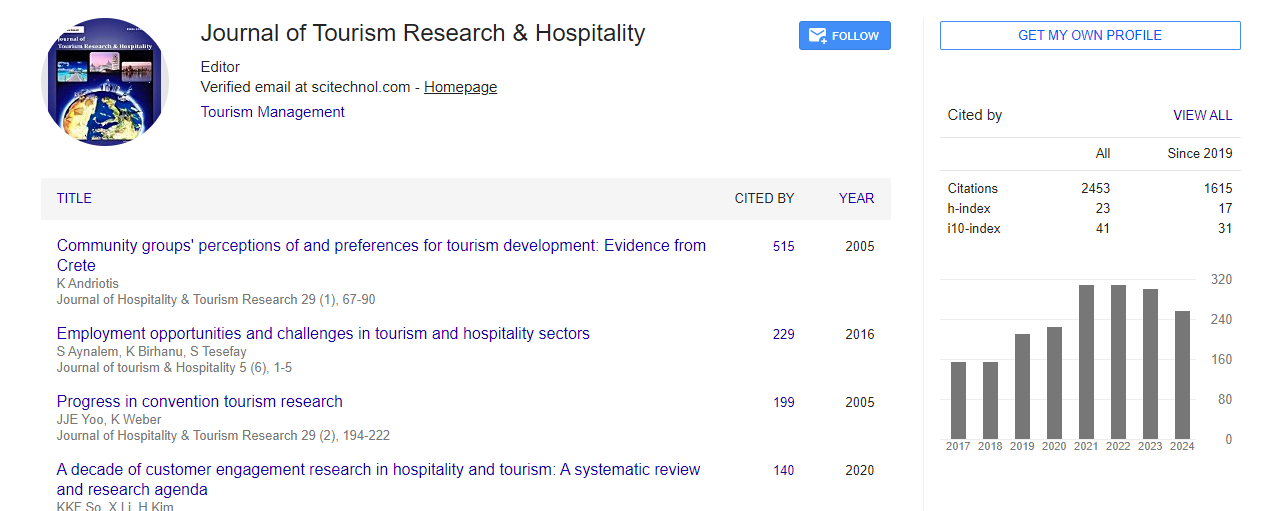Commentary, J Tourism Res Hospitalit Vol: 11 Issue: 2
Assessing the Economic Damage to African Tourism Affected By the Illegal Killing of Elephants
Alison Morrison*
Department of hospitality, National Kaohsiung University of Hospitality and Tourism, Kaohsiung City, Taiwan
*Corresponding Author:
Alison Morrison
Department of hospitality, National Kaohsiung University of Hospitality and Tourism, Kaohsiung City, Taiwan
E-mail:alisonmorrison@gmail.com
Received date: 04 February, 2022, Manuscript No. JTRH-22-54969;
Editor assigned date: 09 February, 2022, Pre QC No. JTRH-22-54969 (PQ);
Reviewed date: 18 February, 2022, QC No JTRH-22-54969;
Revised date: 22 February, 2022, Manuscript No. JTRH-22-54969 (R);
Published date: 25 February, 2022, DOI:10.4172/jtrh.1000221
Citation: Morrison A (2022) Assessing the Economic Damage to African Tourism Affected By the Illegal Killing of Elephants. J Tourism Res Hospitalit 11:2.
Keywords: forest elephants, illegal killing
Introduction
The conservation of savannah (Loxodonta africana) and forest (Loxodonta cyclotis) elephants in Africa is an urgent worldwide issue, as recent increases in poaching have resulted in population reductions of up to 60% across the continent [1,2]. Despite an international commercial trade ban, demand for ivory is reducing or eliminating elephants in large swaths of their former range, with recent surveys estimating that tens of thousands of elephants have been poached in Tanzania and Mozambique alone in the last five years [3]. Reduced ivory demand in Asia, increased incentives for local communities to act as elephant stewards, strengthened frontline conservationists' ability to prevent elephant poaching have all been proposed conservation responses to this crisis [4]. The latter two points necessitate increased investment in elephant conservation efforts by range-country governments. However, given other pressing development priorities competing for limited funding and attention, it is often difficult to justify conservation on a return on investment basis, because the tangible economic benefits of biodiversity conservation are rarely understood [5].
Economic Analysis of Elephants
Using this approach, we hope to better understand how the tourism benefits lost as a result of elephant poaching relate to the enforcement or anti-poaching costs required to prevent elephant population declines due to illegal killing [6]. While addressing an important aspect of elephant conservation and management, this benefit-cost framework is only a small part of what a total economic value study would estimate. Additional potential costs, such as crop damage to local communities and the potential costs of setting aside as well as additional potential benefits, such as elephants ecosystem engineering role and the existence values that people hold for their conservation, would all be considered in a more comprehensive economic study with more data availability [7].
Elephant conservation in African savannah protected areas is a wise investment with immediate and ongoing tourism benefits. Return rates are positive, sometimes strongly positive, in these areas, indicating that tourist's willingness to pay to see elephants as part of a visit to a PA are sufficient to offset the increased costs required to protect elephant populations. These findings are consistent with surveys that show elephants are among the most popular African wildlife species for tourist viewing [8]. Implying that poaching related elephant declines drive tourism losses rather than the other way around. Anecdotal evidence suggests that tourism is under threat or has already declined as a result of the even more catastrophic recent losses of elephants across Africa [9].
Elephant-based tourism cannot be expected to contribute significantly to the conservation of forest elephants in central Africa at the moment. Different funding mechanisms that capture public concern and the 'existence value' of elephants will be required to halt recent declines in these remote, difficult to access areas, where tourism levels are currently lower than in savannahs and elephants, with few exceptions, are difficult to see; examples include the Partnership to Save Africa's Elephants (a Clinton Global Initiative) and the Elephant Crisis Fund [10]. Global forest-based conservation schemes, such as Reducing Emissions from Deforestation and Degradation (REDD+), may also play a role if associated biodiversity considerations, such as elephant conservation, can be included. Our findings also show that biodiversity conservation cannot always be justified solely on financial grounds, and that the 'use values' or 'ecosystem services' that biodiversity provides are complementary to, rather than substitutes for, moral or aesthetic reasons for conservation.
References
- Bhukuth A (2005) Child Labour and Debt Bondage: A Case Study of Brick Kiln Workers in Southeast India. J Asian Afr Stud 40: 287â??302.
[Crossref], [Google Scholar]
- Bronner U, Reikersdorfer C (2016) Urban Nomads Building Shanghai. Int j humanit soc 2: 20-23.
[Crossref], [Google Scholar]
- ILO (2014) Child labor and the right to education in Mexico. Sustainability 10: 1-19.
[Crossref], [Google Scholar]
- Juarez M, Navarrete EL (2016) The family environment and the work of girls and boys from 5 to 11 years old. Mexico in two moments: 2007 and 2013. Papeles de Población 22: 43-72. Pretoria 35: 595-601.
[Crossref], [Google Scholar]
- Kiran U, Singh S (2013) Body discomfort analysis among child labour working in various unorganized sectors. Int j humanit soc 2: 20-23.
[Crossref], [Google Scholar]
- Rashid A, Aziz A (2001) Bangladeshi migrant workers in Malaysia's construction sector. Asia-Pac Popul. J 16: 3-22.
[Crossref], [Google Scholar]
- Wells J (2001) The construction industry in twenty-first century: Its image, employment prospects and skill requirements. Sustainability 11: 1-19.
[Crossref], [Google Scholar]
- Birss M (2017) Criminalizing Environmental Activism. NACLA Report on the Americas 49: 315-322. Build Res Inf 35: 595-601.
[Crossref], [Google Scholar]
- Hallam K (2017) Environmental defenders: Murdered, missing and at risk. Socialist Lawyer 75: 40-43. Pretoria 35: 595-601.
[Crossref], [Google Scholar]
- Pskowski M (2020) In Mexico, Cheap Gas Wins: Promises of consultation are not enough for Indigenous communities in the path of pipeline construction in mexico, an important market for the Texas shale fields. NACLA Report on the Americas (1993), 52: 131-136.
[Crossref], [Google Scholar]
 Spanish
Spanish  Chinese
Chinese  Russian
Russian  German
German  French
French  Japanese
Japanese  Portuguese
Portuguese  Hindi
Hindi 

